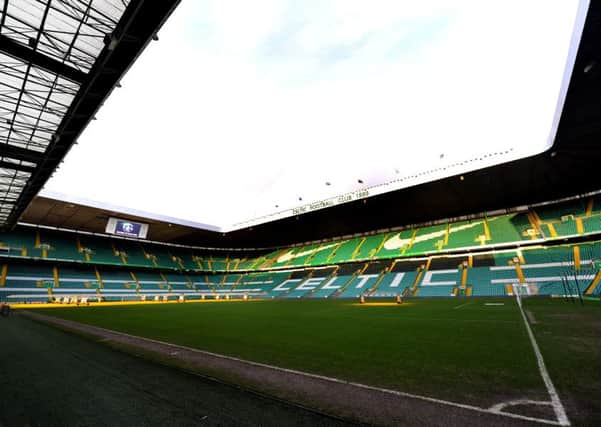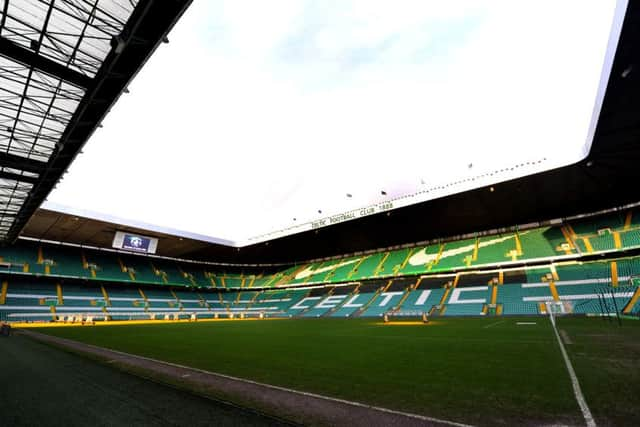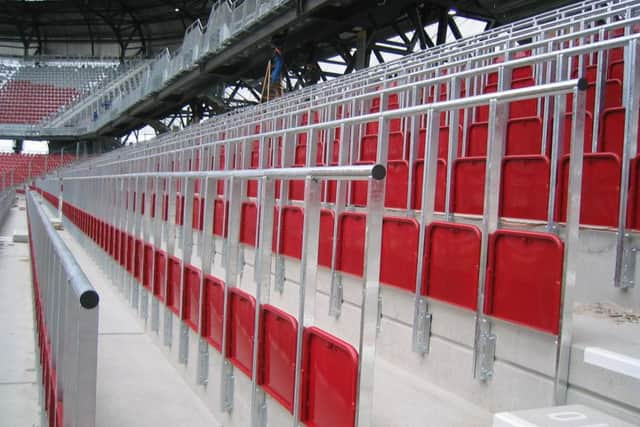Celtic given go-ahead for ‘safe standing’ area


This part of the ground, the conclusion of five years’ worth of dialogue with authorities, is scheduled to be open in time for the start of the 2016-17 season.
Celtic chief executive Peter Lawwell said the club had worked “tirelessly” on the issue. Yesterday’s news comes after Celtic were twice handed knock-backs by Glasgow City Council after applying for a safe standing licence. Now the Scottish champions will invest £500,000 in installing a safe standing area that will have capacity for 2,600 people in lower tier of the north-east corner at Celtic Park, an are of the ground which usally houses the Green Brigade group of supporters. With the majority of season tickets already sold for next season, work is likely to begin next summer.
Advertisement
Hide AdAdvertisement
Hide Ad“We are delighted that this permission has finally been granted,” said Lawwell. “The introduction of rail seating at Celtic Park represents an investment in spectator safety.”
Rail seating is a system that is already used to good effect in German stadiums in the Bundesliga and has led to a marked improvement in the matchday atmosphere.
“Across football globally, the reality is that some supporters are choosing to stand at matches,” added Lawwell. “This is something we must accept and manage and also understand the positive effect which these areas have on atmosphere at matches.
“Celtic’s primary objective will always be the safety and comfort of its supporters – this new system will now allow fans to stand safely at matches. Rail seating has been in place in European football for some time and there has been considerable demand for some form of ‘safe standing’ within the UK and particularly from our supporters.”
The move has been greeted with enthusiasm by Supporters Direct Scotland, who hoped that safe standing areas would now become a feature of Scottish football grounds at all levels. “Supporters Direct Scotland welcomes this development and hopes that it signals the beginning of more work being done to improve the matchday experience for fans, to make it more affordable and more enjoyable,” said Andrew Jenkin, head of SDS.


“SDS calls on the relevant decision makers to help allow all clubs the opportunity to introduce safe standing where applicable, across all SPFL divisions”.
Scotland is not bound by the law which bans standing at top-flight football fixtures in England. This country’s football authorities only adopted recommendations in the Taylor report following the Hillsborough disaster in 1989, when 96 people were crushed to death.
All-seater stadiums became compulsory in England’s top flight in 1994 while a requirement for access to the top flight following the formation of the Scottish Premier League in 1998 was a 10,000 capacity all-seater stadium. This criterion was later reduced to 6,000.
Advertisement
Hide AdAdvertisement
Hide AdAt an SPL general meeting in 2011, clubs agreed to relax these rules and ushered in the prospect of standing areas returning to the Scottish game at the highest level. However, local authorities, including representatives of Police Scotland, must give the green light. Glasgow City Council is now satisfied that Celtic have answered all its concerns.


Independent safety and security expert Dr Steve Frosdick, who has been closely involved with Celtic’s application to the city council, described the move as “pioneering”.
He added: “For the first time in the UK, football fans will be able to stand and watch the game from purpose-built accommodation which is demonstrably safe. The club and its fans are to be congratulated for the way they have worked together to make the case for the authorities.”
“I think most clubs will be broadly supportive,” said Alan Burrows, the general manager at Motherwell. Burrows did add the caveat that, as ever, the financial implications of installing such an area would be a critical factor. Individual rail seats can cost as much as £75 per person to install.
Hearts, meanwhile, have also vowed to consider the implementation of a safe standing area but must first decide on the future of Tynecastle, which has long been under discussion.
“Heart of Midlothian Football Club is currently and continuously looking for ways to improve the supporter experience at Tynecastle,” said Scot Gardiner, the chief operating officer at the club. “While safe standing is something the club will definitely consider in the future, our priority remains looking at all aspects of the stadium and the viability of staying at Tynecastle, our preferred option.
“As part of this wide-ranging study, all aspects, including safe standing, will be thoroughly explored.”
Margeret Aspinall, chairperson of the Hillsborough Family Support Group, has protested against standing areas ever being permitted again at top-flight football matches.
Advertisement
Hide AdAdvertisement
Hide Ad“We have seen at Hillsborough what can happen when things go wrong,” said Aspinall., whose son was killed at Hillsborough. “We have come ten steps forward since then and I do not know why anyone would want to go backwards.”
Kenny Dalglish, who was manager of Liverpool the day they played Nottingham Forest in the ill-fated FA Cup semi-final clash at Hillsborough, has also described a return to standing as an “unnecessary risk”.
However, in Germany in particular football grounds have been adapted with great success to provide safe standing areas. Rail seats are locked in upright position for domestic games, then unlocked for European or international matches, where standing is still prohibited.
Scottish Football Association chief executive Stewart Regan said the idea of a similar initiative for Hampden Park had not been contemplated. However, he added he would keep an eye on Celtic’s pilot scheme.
“At this stage it’s not something that we’ve even contemplated,” he said. “We’ll monitor the pilot at Celtic Park and see how that goes. I know that Celtic spent a lot of time talking with Glasgow City Council and also with the Scottish Government and police and we’ve always said that if all of those stakeholders were happy and there was no safety issues that could be possibly foreseen for fans coming into the ground then we would support it.